
Abandoned & Little-Known Airfields:
Northeastern South Carolina
© 2002, © 2024 by Paul Freeman. Revised 1/31/24.
This site covers airfields in all 50 states: Click here for the site's main menu.
____________________________________________________
Please consider a financial contribution to support the continued growth & operation of this site.
Coulbourne Airport (revised 1/31/24) - Cypress Bay Airport (revised 1/28/24) - Hemingway-Stuckey Airport (added 2/3/22)
Kershaw Airport (revised 2/20/17) - Lane Airport (revised 5/6/20) - Palmer Field / Bennettsville Airport (revised 2/9/22)
____________________________________________________
Palmer Field / Bennettsville Airport, Bennettsville, SC
34.656, -79.719 (Southeast of Charlotte, NC)

Palmer Field, as depicted on the April 1944 Charlotte Sectional Chart.
According to the SC Encyclopedia, “A pilot training airfield & German prisoner-of-war camp located near Bennettsville from 1941-1945,
Palmer Field was named in honor of Captain William Palmer, a Bennettsville resident who earned a Distinguished Service Cross in World War I serving with Eddie Rickenbacker’s 94th Pursuit Squadron.
Built in the summer of 1941 on the site of several abandoned cotton fields, the airfield included barracks, a ground school, and administration buildings.
The U.S. Army contracted with the Georgia Air Service to operate the flight school.
In October 1941 the first cadets began training with a civilian staff of 16 flight instructors,
which grew to 59 by the end of the following month along with some 200 support personnel.
Palmer Field was a primary training facility, the first of 3 stages toward earning a pilot’s commission.
Each class trained on Stearman PT-17s for 9 weeks before moving on to the next stage at another field.
The first graduating class had its ceremony disrupted on 12/7/41 because of the Japanese attack on Pearl Harbor that day.”
According to Bret Kepner, “The property was owned by SC Senator Paul Wallace, who may have owned the land prior to the war.”
Palmer Field not yet depicted on the August 1942 Charlotte Sectional Chart.
According to the SC Encyclopedia, “An estimated 2,000 trainees came through Palmer from 1941 until early 1944.”
A 4/19/43 The State article (courtesy of Bret Kepner) entitled “Marlboro base to be named for Captain Palmer”, read:
“The Marlboro county airport will be named after the late Captain William Palmer, son of Mr. & Mrs. H.W. Palmer of Bennettsville.”
A 4/30/43 Charlotte News article (courtesy of Bret Kepner) entitled “Johnston will dedicate base”, read:
“Palmer Field, Marlboro County's new air base, will be dedicated here May 10. Governor Olin Johnston is scheduled as principal speaker.”
The earliest depiction which has been located of Palmer Field was on the April 1944 Charlotte Sectional Chart.
It depicted Palmer as a commercial/municipal airport.
According to the SC Encyclopedia, “Late [in 1944] Palmer Field became a prisoner-of-war camp for an estimated 244 Germans who were employed on local farms & forestry enterprises.”
A 2/24/45 Charlotte Observer article (courtesy of Bret Kepner) entitled “250 prisoners of war reach Bennettsville”, read:
“Two hundred fifty German prisoners of war have arrived here & are housed in part of the barracks at Palmer Field,
former primary flight training school operated by the Southeastern Air Service.”
According to the SC Encyclopedia, “By the middle of 1945 the camp was deactivated.
Later the site served as a drive-in movie theater & then a chicken farm.”
The last depiction which has been located of Palmer Field was on the October 1946 Charlotte Sectional Chart.
It depicted Palmer as an auxiliary airfield.
A 4/5/47 The State article (courtesy of Bret Kepner) entitled “Marlboro County to get former Army Air Field”, read:
“Senator Paul Wallace announced today that he had received confirmation from the Civil Aeronautics Administration
that it is turning to Marlboro County the 65 acres of land & 14 of the buildings, landing facilities & equipment at Palmer Field,
used during the war as an AAF primary air school.
The property is to be used for airport purposes for civil aviation in the CAA national airport plan.”
Palmer Field was no longer depicted on the 1947 through April 1948 Charlotte Sectional Charts.
Bennettsville Airport was reopened in 1948 at the site of Palmer Field, as that is how it was depicted on the October 1948 Charlotte Sectional Chart.
A 7/9/50 The State article (courtesy of Bret Kepner) entitled “Stevens plan to use Bennettsville hangar”, read:
“Announcement has been made by Senator Paul Wallace that a contract has been signed with the Stevens Company
for use of one of the hangars at Palmer Field for inspection of goods completed at their new plant at Kollock & for storage.
A cropdusting company uses one of the hangars.”

The earliest photo which has been located of Bennettsville Airport was an 11/28/50 USGS aerial view.
It depicted 4 hangars & a large number of barracks buildings on the north side of a paved ramp, with an irregularly-shaped grass airfield.

The earliest topo map depiction which has been located of Bennettsville Airport was on the 1954 USGS topo map.
A 1957 USGS aerial view depicted Bennettsville Airport in an unchanged configuration.
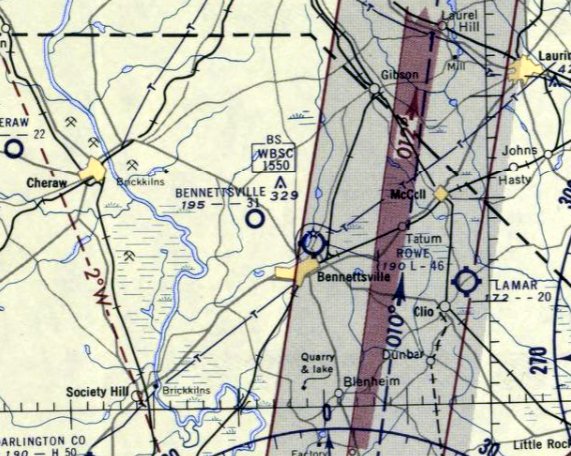
The last aeronautical chart depiction which has been located of Bennettsville Airport was on the August 1957 Charlotte Sectional Chart.
It depicted Bennettsville as having a 3,100' unpaved runway.
According to Bret Kepner, “The dragstrip was paved in the middle of the airfield & opened on on 10/18/57,
as what we refer to as a 'grass median strip' in which paving expenses are cut by laying two 15' 'lanes' of asphalt (with a 6' grass median), rather than one 40' wide strip.
We believe the rack ran eastward.
There's an interesting twist to the ownership of the property by Senator Paul Wallace.
Not only did he put his son, Paul, Jr., in charge of operating the drag strip but Sr's political rivals created quite an uproar over the fact he used County equipment to BUILD the track.
The Senator pretty much blew off the insinuation.”
According to dragstriplist.com, Bennettsville Drag Strip operated from 1957, sanctioned by the International Timing Association.
Bennettsville Airport was no longer depicted on the 1958 Charlotte Sectional Chart.
According to Bret Kepner, “The Bennettsville Drag Strip operated through 1960.”

An undated photo looking northeast at Bennettsville Airport from the 8/20/60 Florence Morning News (courtesy of Bret Kepner).
The caption read: “Site for industry: The long-deserted Word War II Air Air Corps air base on Highway 9 northwest of Bennettsville has been acquired by the Marlboro Agricultural & lndustrial Development Board.
The organization hopes to convert the area into an industrial park. In addition to the paved strip, the area includes a huge acreage of level land in addition to crumbling hangars, barracks, and other buildings.
The paved runway is used now as a drag strip for races.”
According to the SC Encyclopedia, “Powell Manufacturing purchased it for manufacturing tobacco-growing equipment in the early 1960s.”

A 2014 photo looking southeast at the Palmer Field hangars, showing the characteristic WW2 hangar architecture of 2 arched-roofs connected by a peaked roof in between.

A 2014 photo looking northwest at the Palmer Field hangars, showing the characteristic WW2 hangar architecture of 2 arched-roofs connected by a peaked roof in between.
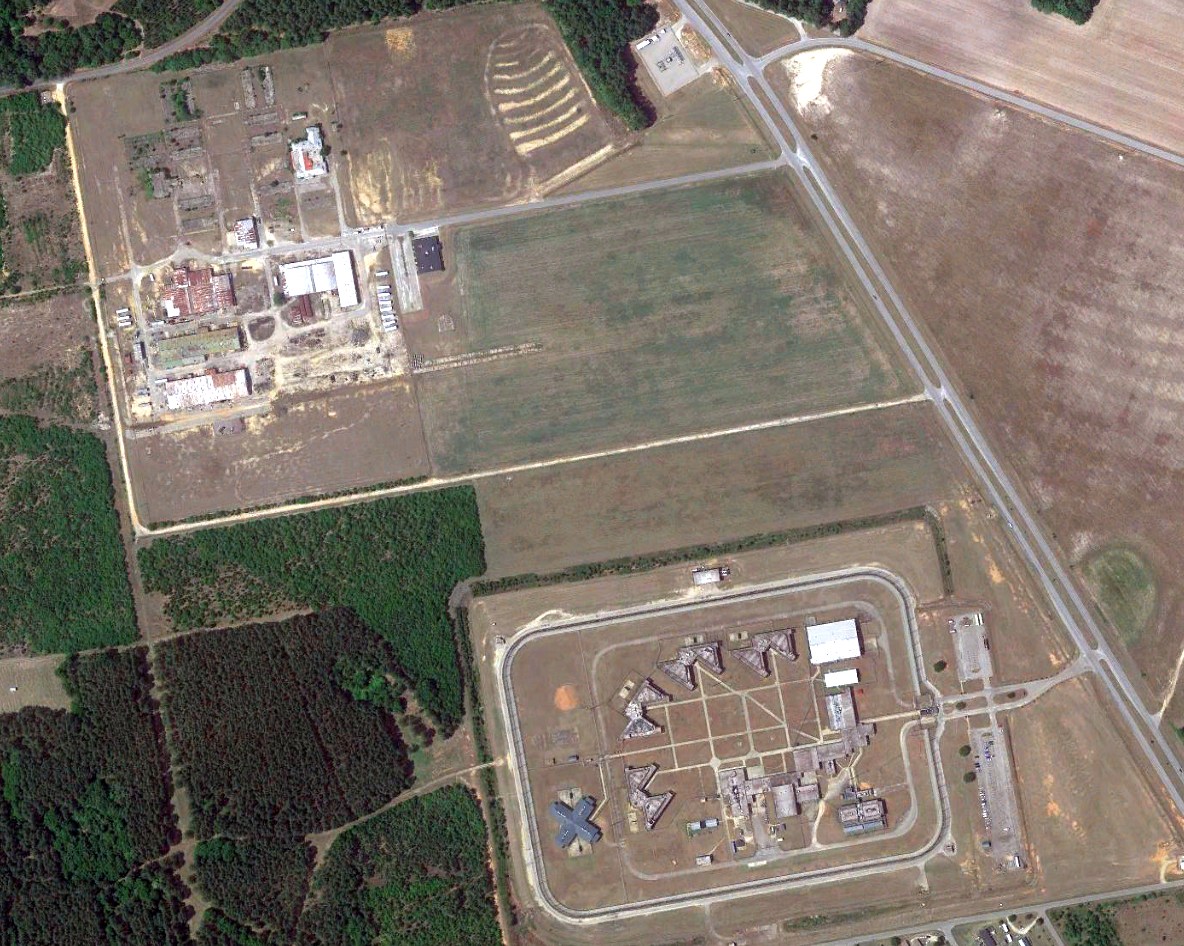
A 2021 aerial view of the site of Palmer Field, showing the hangars & barracks building foundations on the north side, and the prison which covers the southeast side of the airfield area.
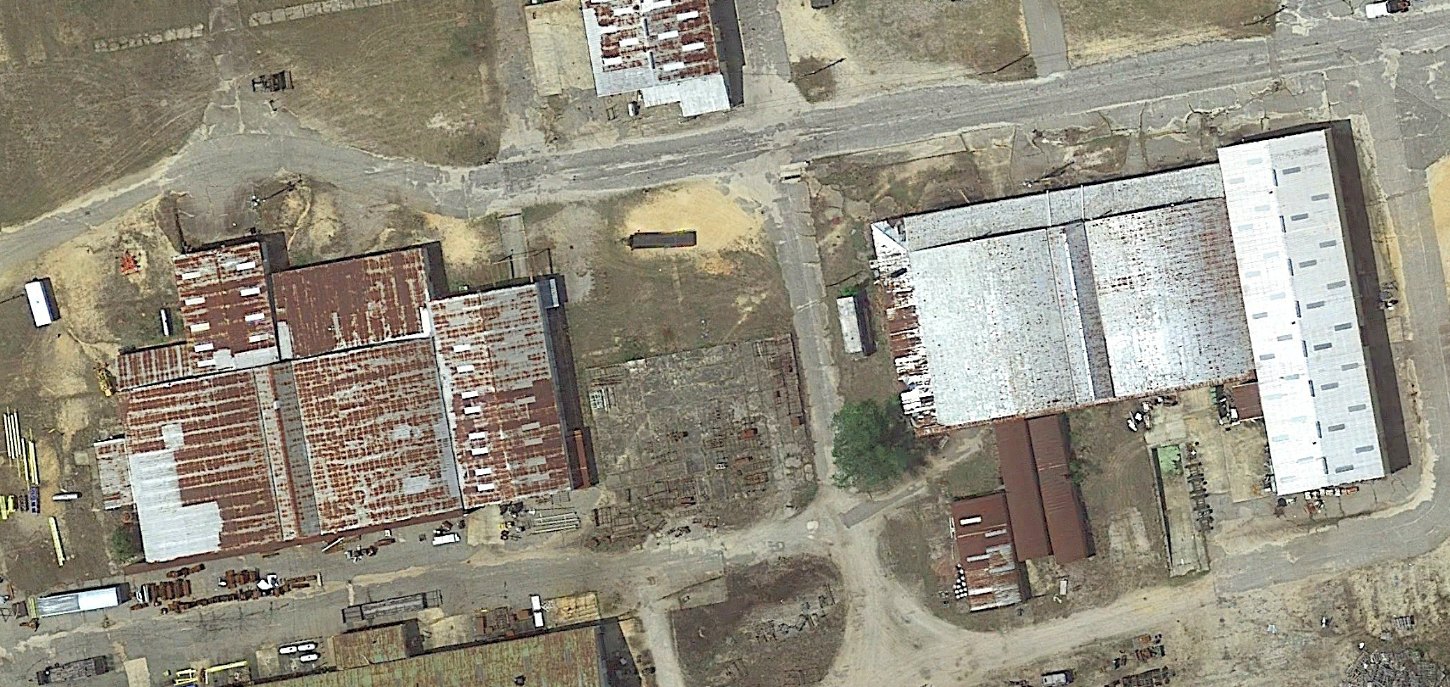
A closeup from the 2021 aerial view showing the WW2-era hangars which remain on the north side of the Palmer Field site.
As of 2023, street maps label the site of Bennettsville Airport as Southeastern Sales.
According to Bret Kepner, “The property is now the northern boundary of the Evans Correctional Facility, the perimeter of which is located 820' to the south.”
Thanks to Bret Kepner for pointing out this airfield.
____________________________________________________
Hemingway-Stuckey Airport (38J), Stuckey, SC
33.729, -79.516 (West of Myrtle Beach, SC)

Hemingway-Stuckey Airport, as depicted on the March 1965 Savannah Sectional Chart.
The date of establishment of this small general aviation airport has not been determined.
Hemingway-Stuckey Airport was not yet depicted on the 1946 USGS topo map.
Hemingway-Stuckey Airport was evidently established several years before being depicted on aeronautical charts,
as a 1955 aerial view showed it having a single unpaved northwest/southeast runway.
But there were no buildings or aircraft visible at the airfield.
Hemingway-Stuckey Airport was not yet depicted on the January 1961 Savannah Sectional Chart.
The earliest depiction which has been located of Hemingway-Stuckey Airport was on the March 1965 Savannah Sectional Chart.
It depicted Hemingway-Stuckey Airport as having a single paved 2,000' northwest/southeast runway.

The September 1968 Savannah Sectional Chart showed Hemingway-Stuckey Airport's runway as having been slightly lengthened to 2,500'.
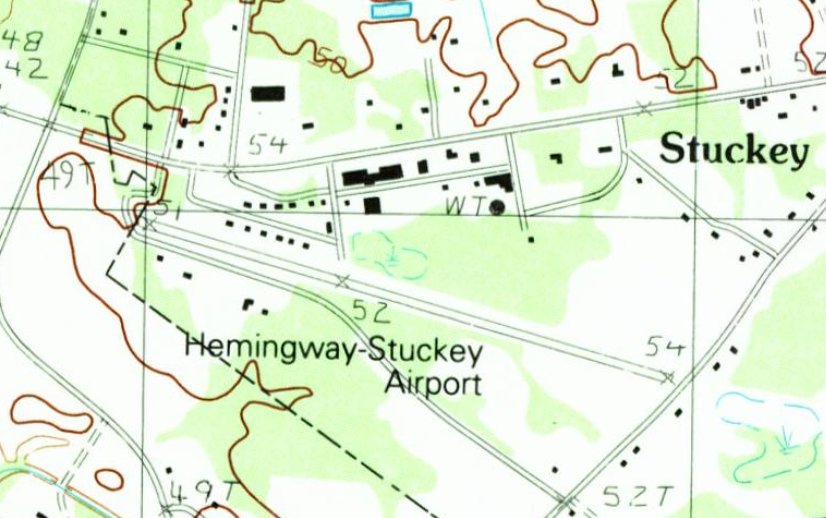
The 1990 USGS topo map depicted Hemingway-Stuckey Airport as having a single paved northwest/southeast runway, with rows of small buildings along the northwest & southwest sides.
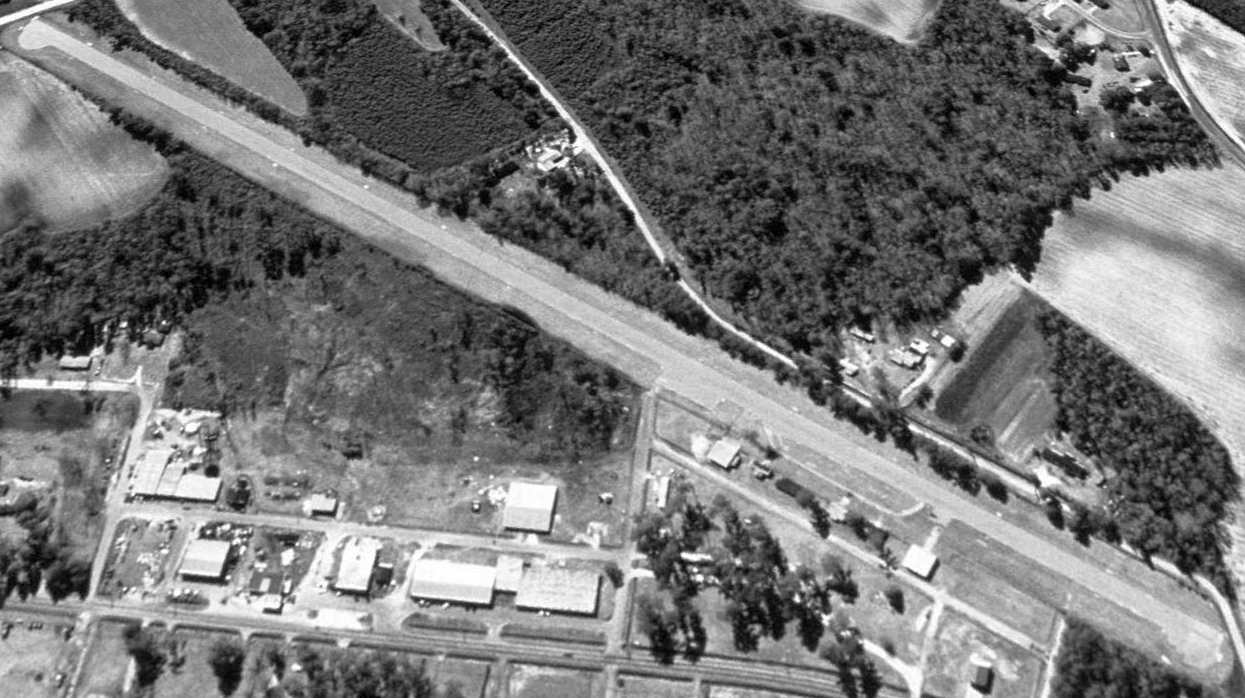
The earliest photo which has been located of Hemingway-Stuckey Airport was a 1994 USGS aerial view looking southeast.
It depicted Hemingway-Stuckey Airport as having a single paved northwest/southeast runway, with a row of small buildings along the northwest sides.
There were no aircraft visible on the field.
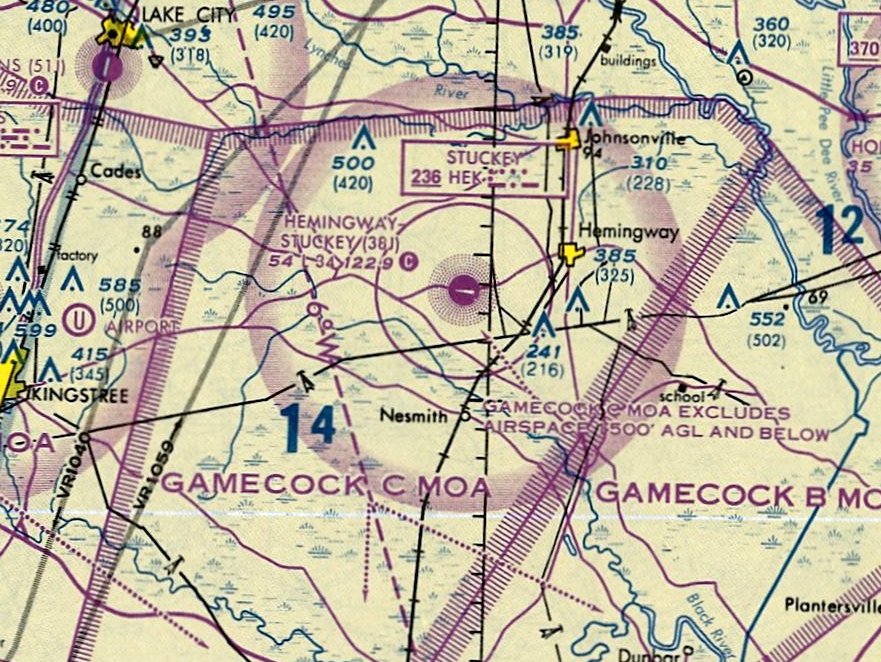
The last aeronautical chart depiction which has been located of Hemingway-Stuckey Airport was on the February 1994 Savannah Sectional Chart.
It depicted Hemingway-Stuckey Airport as having a single paved 3,400' northwest/southeast runway.

An undated photo from a 2009 article looking along the overgrown Hemingway-Stuckey Airport runway.
A 2009 article (courtesy of Brad Baisley) said there were plans to revitalize the Hemingway-Stuckey Airport runway, but evidently that did not materialize.
Unfortunately a 2014 article (courtesy of Brad Baisley) said Hemingway-Stuckey Airport would be closed due to its poor condition.

A January 2016 photo looking southeast at a Hemingway-Stuckey Airport hangar & the runway. Several other hangars had been removed at some point between 2008-20016.

A 2017 aerial view looking southeast at the Hemingway-Stuckey Airport, showing it to remain intact, but with yellow closed-runway “X” symbols painted on the runway.
Thanks to Brad Baisley for pointing out this airfield.
____________________________________________________
Cypress Bay Airport (5J6), Little River, SC
33.876, -78.627 (Northeast of Myrtle Beach, SC)

Cypress Bay Airport, as depicted on the 1978 USGS topo map.
This small general aviation airport was evidently established at some point between 1970-78,
as it was not yet depicted at all on the September 1970 Savannah Sectional Chart (courtesy of Ron Plante).
The earliest depiction of Cypress Bay Airport which has been located was on the 1978 USGS topo map.
Storm Bear recalled, “I have photos of Cypress Bay Airport from 1984. Back then, it was mostly a glider operation taking tourists for rides.”
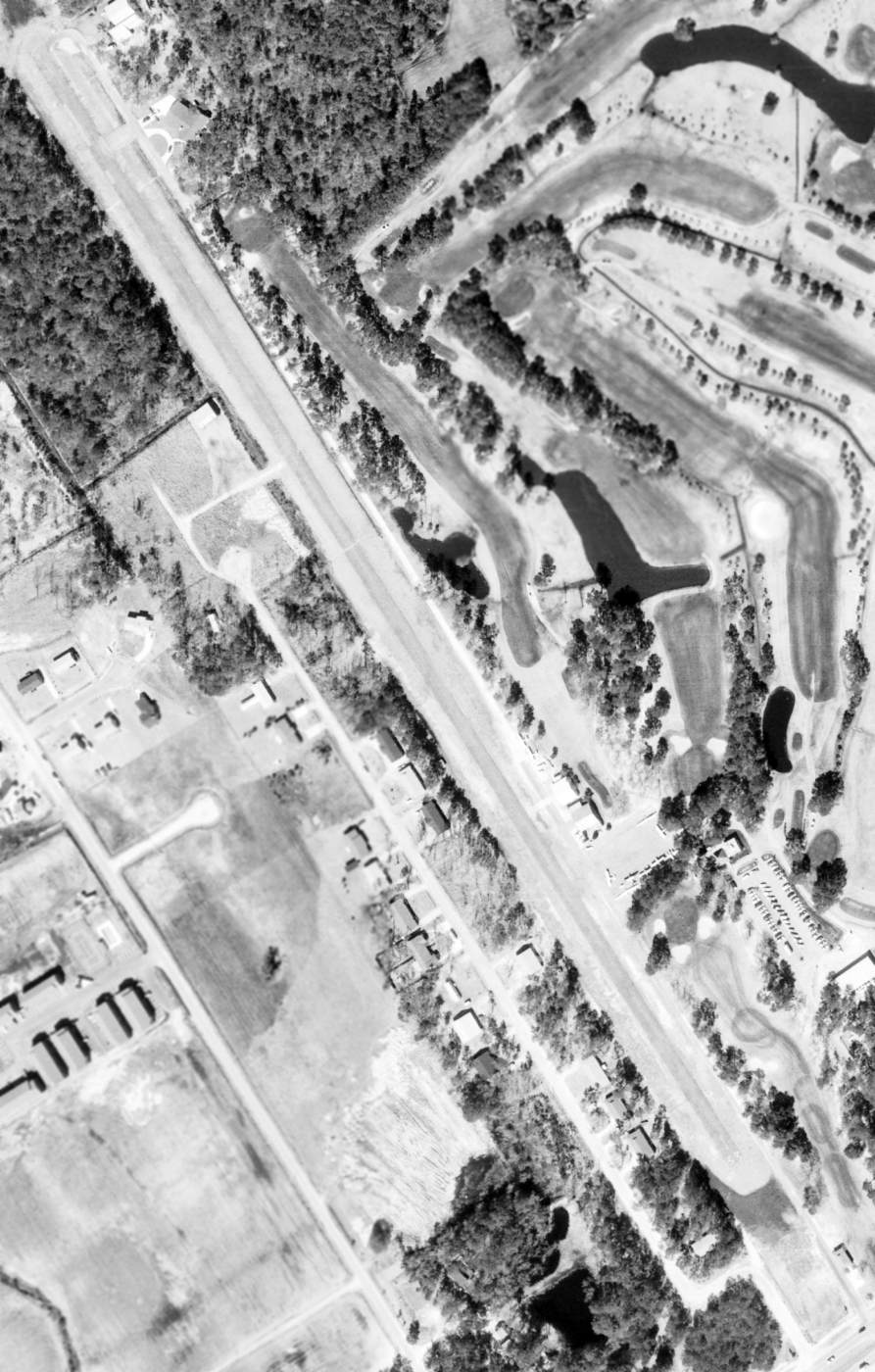
The earliest photo which has been located of the Cypress Bay Airport was a 3/3/87 USGS aerial view.
It depicted Cypress Bay as having a paved Runway 15/33 with a few small buildings on the east side, near which were parked 9 light aircraft.

The 1990 USGS topo map depicted Cypress Bay Airport as having a paved northwest/southeast runway with a paved parallel taxiway,
and several small buildings along the southwest side.

The only aeronautical chart depiction which has been located of the Cypress Bay Airport was on the February 1994 Charlotte Sectional Chart (courtesy of Ron Plante).
It depicted Cypress Bay as a private airfield having a 2,900' paved northwest/southeast runway.

The last photo which has been located of the Cypress Bay Airport was a 1/22/94 USGS aerial view looking northwest.
It depicted Cypress Bay as having a paved Runway 15/33 with a few small buildings on the east side.
Five light aircraft were visible on the field.
Cypress Bay Airport was evidently closed at some point between 1994-99,
as a 2/16/99 aerial view showed that the property had been covered with housing.

A 6/9/11 aerial view looking northwest showed housing covering the site, with no trace remaining of Cypress Bay Airport.

A 4/7/12 photo by Paul Freeman looking north at The Gardens at Cypress Bay, which covers the site of the Cypress Bay Airport.
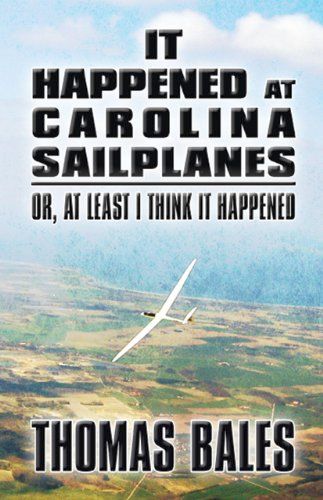

An 8/14/13 photo by Kevin Kuhn of Cessna 150E serial #15061509 N6209R, which is mounted above the end of one of 2 former hangars which remain on the northwest side of the site of Cypress Bay Airport.
Kevin reported, “The Cessna itself wasn't a resident of the airport, so far as I know.
The info on surviving hangars was related to me by the owner of the house it's now attached to; the hangar with the Cessna is now his garage.
Based on info from the Horry County Auditor it may have been built in 1985 or 1991.
The other hangar appears to have been converted into a house, and based again on the auditor data it was built in 1993.”
The site of Cypress Bay Airport is located north of the intersection of Hibiscus Drive & Route 17.
____________________________________________________
Coulbourne Airport, Lancaster, SC
34.69, -80.78 (South of Charlotte, NC)

Coulbourn Airport, as depicted on the February 1942 Charlotte Sectional Chart.
Coulbourn Airport was evidently established at some point between 1941-42,
as it was not yet depicted at all on the November 1941 Sectional Chart.
The earliest depiction of Coulbourn Airport which has been located was on the February 1942 Charlotte Sectional Chart.
It depicted Coulbourn as a commercial/municipal airport.

An aerial view looking north at Coulbourn Airport from the March 1945 SC Airport Directory (courtesy of Bo Bowman).
The directory described Coulbourn as having 2 sod runways: 2,000' northwest/southeast & 1,800' northeast/southwest.
The field was said to be privately owned, to consist of a total of 50 acres, and to offer fuel.
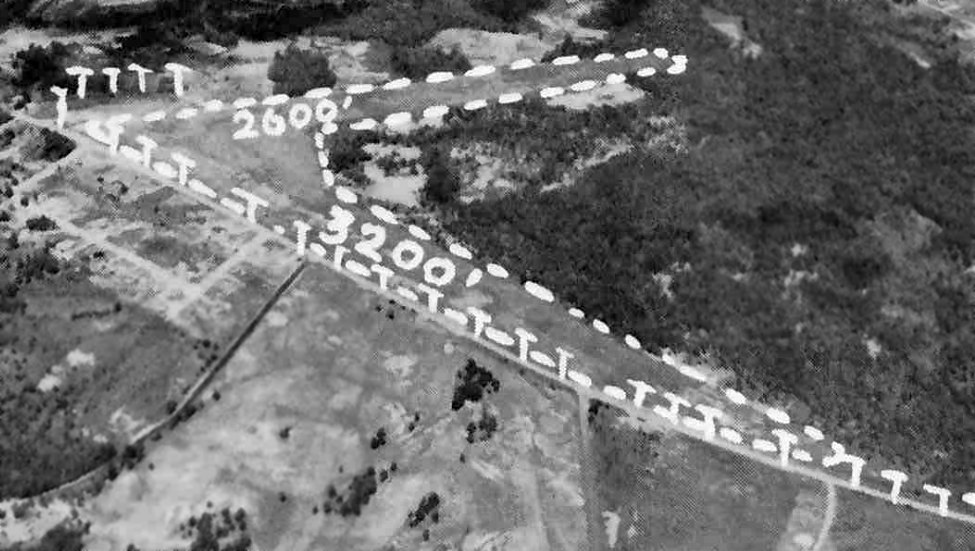
An undated aerial view looking north at Coulbourn Airport from a circa 1957 SC Airport Directory (courtesy of Don Fraser).
The directory described Coulbourn as county-owned, and lacking an operator.

The only photo which has been located showing aircraft at Coulbourn Airport was a 2/23/64 USGS aerial photo.
It depicted Coulbourn as having 2 grass runways, with 2 small hangars & 3 single-engine aircraft on the west side.
NTSB records indicate that a Cessna 150 had its landing gear collapse following a hard landing at Coulbourn Airport on 4/7/68.
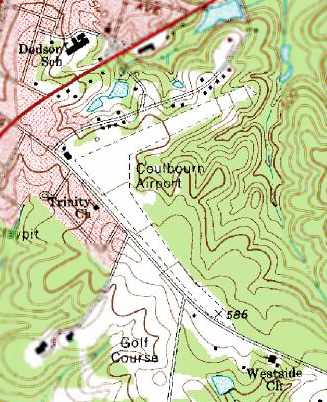
The 1969 USGS topo map depicted Coulbourn Airport
as having 2 unpaved runways, with a single building (a hangar?) west of the runway intersection.
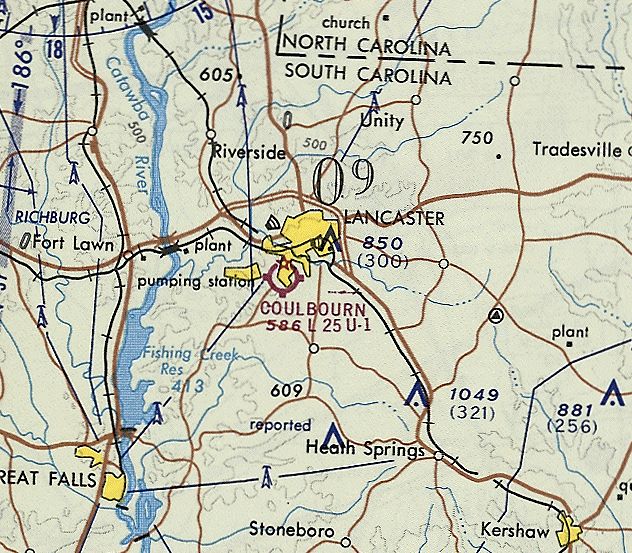
The last aeronautical chart depiction which has been located of Coulbourn Airport
was on the September 1970 Charlotte Sectional Chart.
It depicted Coulbourn as a public-use airport having a 2,500' unpaved runway.
Jim Stewart reported, “James Kirk said he landed at Coulbourn many times.”
Coulbourn Airport was evidently closed (for reasons unknown) at some point between 1970-71,
as it was no longer depicted at all on the 1971 Sectional Chart (according to Chris Kennedy).
The area of wooded property & surrounding residences was still named “Airport Crossroads” on the 2003 Lancaster County Map, according to Bo Bowman.
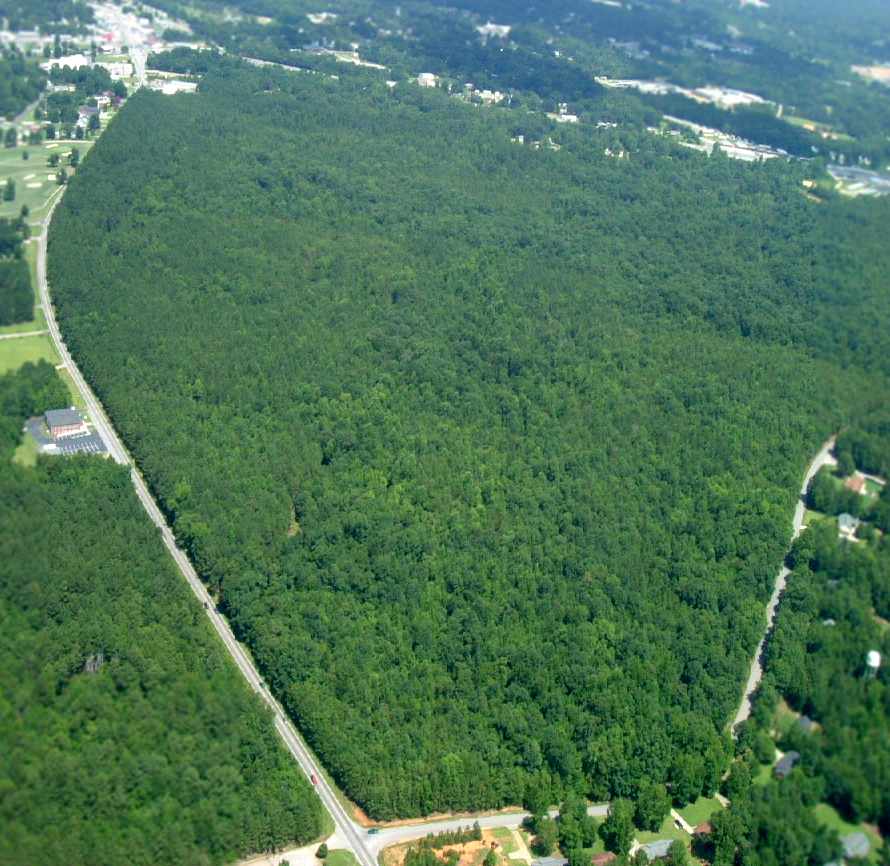
A 7/17/06 aerial view by Bo Bowman looking north at the site of Coulbourn Airport.
Bo observed, “The runways were located in the center of the approximate triangle of thickly wooded property formed by three roads.”
No recognizable trace of the airport appeared to remain.
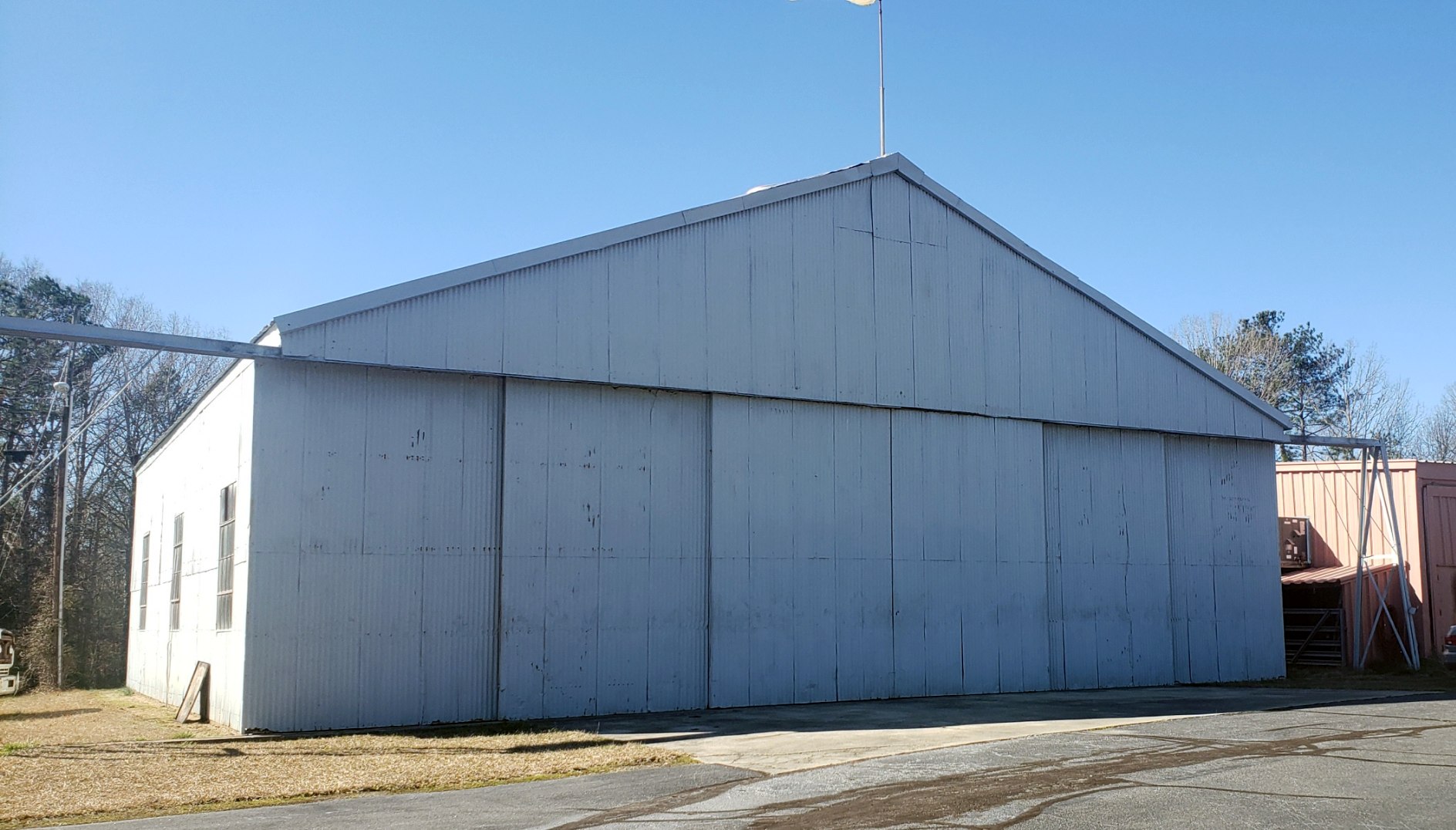
A 1/29/24 photo by Jim Stewart of a Kirk Air Base hangar, which James Kirk said had been moved from Coulbourn Field.
The site of Coulbourn Airport is located east of the intersection of Edgeport Drive & Airport Road, appropriately enough.
Thanks to Bo Bowman for pointing out this airfield.
____________________________________________________
Lane Intermediate Field / Lane Airport (43J), Lane, SC
33.483, -79.889 (North of Charleston, SC)

Lane Airport, as depicted on the January 1935 Savannah Sectional Chart.
The date of construction of the Lane Airport has not been determined.
It was evidently built as one of the Department of Commerce's network of intermediate fields,
which were established in the 1920s & 1930s for the emergency use of commercial aircraft flying along airways between major cities.
The earliest reference to the field which has been located was in The Airport Directory Company's 1933 Airports Directory (courtesy of Chris Kennedy).
It listed the Lane Airport as the Department of Commerce's Site 24, along the Jacksonville-Richmond Airway.
The airfield was said to consist of a rectangular sod field, measuring 2,800' x 2,350', and the field was said to have a rotating beacon.
The earliest depiction of Lane Airport which has been located was on the January 1935 Savannah Sectional Chart, which depicted Lane as Airway Site 24.
The Airport Directory Company's 1937 Airports Directory (courtesy of Bob Rambo)
listed the Lane Airport as the Department of Commerce's Site 24, along the Jacksonville-Richmond Airway.
The airfield was said to consist of a rectangular sod field, measuring 2,800' x 2,500', and there was said to be a shed & a rotating beacon.
The November 1940 Savannah Sectional Chart (courtesy of Chris Kennedy) depicted Lane as the Department of Commerce's Site 24.
Larry Gamble recalled, "The airport in Lane built up during WW2 as a training base with a squadron of P-39 Aircobras.
It was an auxiliary field to handle overflow from other Air Corps bases that were getting too crowded.
The Army contracted with local homeowners to provide 'Bed & Breakfast' type accommodations.
The Squadron Commander plus several pilots stayed in my Great Uncle's home
and another group of pilots lived at Grandfather's home & in an 'over-the-garage' apartment.
I think this all started in late 1942 or early 1943 & lasted until early 1945."
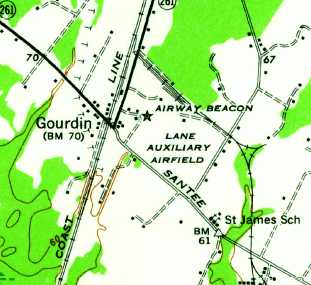
The 1943 USGS topo map depicted Lane Auxiliary Airfield as an open area with an Airway Beacon on the west side.
Lane Airport was depicted on the 1943 Savannah Sectional Chart (courtesy of Chris Kennedy)
as the Department of Commerce's Site 24.
According to Bill Saavedra of the Air Force History Office, “There is an accident report of a BT-15 which crashed near Lane, SC
on 7/21/43 that refers to 'Lane Auxiliary Field' & discussions with the Lane Control Tower.”
The April 1944 US Army/Navy Directory of Airfields (courtesy of Ken Mercer)
listed Lane as "Site 24, JX-RW", and described the field as having a 3,400' unpaved runway.
The field was listed as conducting Army flight operations.
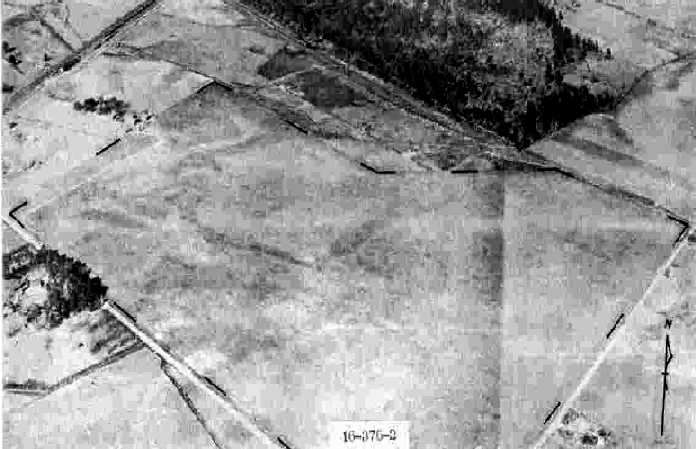
A circa 1943-45 aerial view looking north at “Lane Intermediate Field” from the 1945 AAF Airfield Directory (courtesy of Scott Murdock).
The directory described Lane as a 120-acre irregularly-shaped field having 3 sod runways, the longest being the 3,400' north/south strip.
The field was said to have a single 30' x 9' wood hangar, to be owned by private interests, and operated by the Civil Aeronautics Administration.
According to Larry Gamble, "After the war, the Air Corps left the field but there was a single hangar, lighted runway, rotating beacon, radio beacon, and lighted taxiways.”
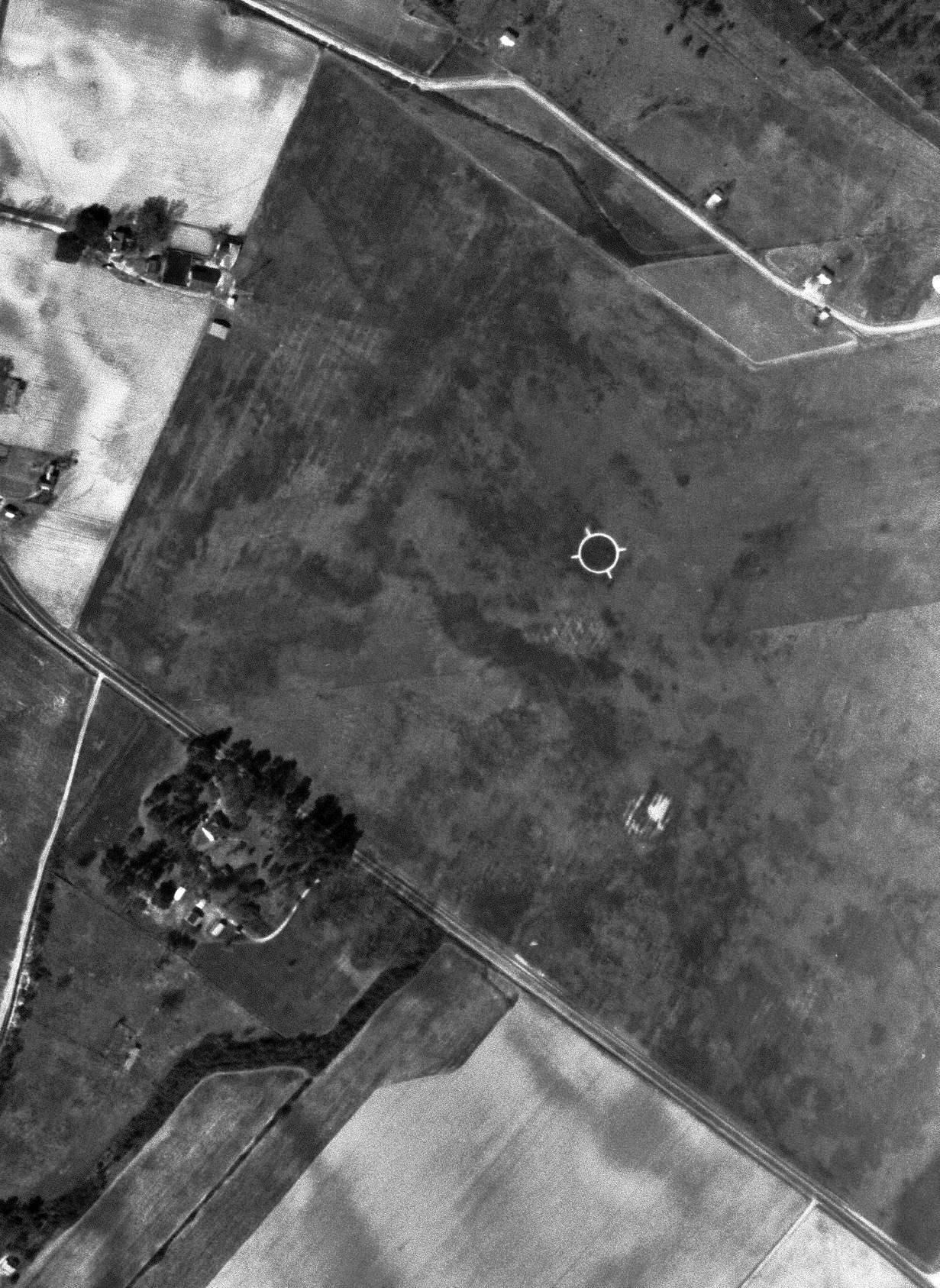
A 3/10/57 USGS aerial view of the western portion of Lane Airport showed the field to have 2 grass runways, with a prominent airport circle marking at the runway intersection.
Several small buildings were located on the west side.
According to Larry Gamble, "The radio beacon was removed in the 1960s by the FAA."
"FAA Site 24" at Lane was described in the 1962 AOPA Airport Directory as having 2 turf runways: 3,464' Runway 13/31 & 3,347' Runway 4/22.
The field was said to be unattended, and the operator was the FAA.
According to Bill Carter, "Many people in Kingstree remember planes practicing take off & landing at the site.
I know the family that owns the property where the airport was.
I remember him telling me they tore down the tower in the 1970's & sold the metal for scrap."
Alton McCullough recalled, "My grandfather Wayne Gamble, my father Alton McCullough,
and my uncle JP Gamble used this airport through the 1970s and maybe into the early 1980s."
Larry Gamble recalled, "I grew up in the area of that airport.
My family leased the airport from the Brown family, who were farmers.
We were also farmers & operated crop dusters from there.
The old hangar built by the Air Corps sheltered our Cessna 182.
In the early 1970's all but the longer, east-west runway & a single taxiway to the hangar were plowed under to grow crops.
I soloed there on my 16th birthday in 1979.
At one time C-130 aircraft from Pope AFB would use it for it's 'unimproved runway' to practice landings.
It sat on a flyway at WESEL intersection on the Jacksonville sectional & very easy to find."
The 1982 AOPA Airport Directory (courtesy of Ed Drury) listed the Lane Airport as having 2 turf runways: 3,464' Runway 16/34 & 3,347' Runway 9/27.
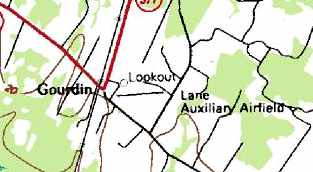
"Lane Auxiliary Airfield", as depicted on the 1983 USGS topo map.
Lane's former second runway had apparently been abandoned, as this & subsequent topo maps only depicted a single east/west runway.
Larry Gamble recalled, "The airport saw continuous operation until 1983.
Finally, in 1983, my father sold our Cessna & the airport was tilled once more returning the entire area to crop land."
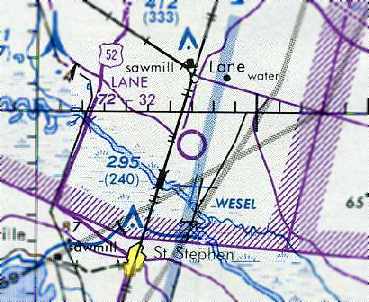
However the Lane Airport continued to be depicted on aeronautical charts
as late as on the August 1988 Savannah Sectional Chart (courtesy of Chris Kennedy).
It depicted Lane as a public-use airport having a 3,200' unpaved runway.
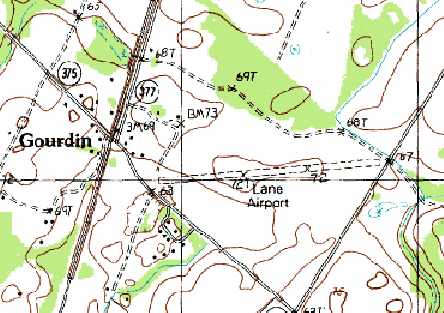
"Lane Airport", as depicted on the 1990 USGS topo map.

In a 1994 USGS aerial view looking northwest at the site of Lane Airport. the outline of a single east/west runway was still apparent in a large open field.
The outline of the former compass rose was also still apparent, in the middle of the runway.
According to Larry Gamble, the former hangar, beacon tower, and control shed for the beacons
were located just west of the former runway, but have all been removed.
Larry also reported in 2004 that Lane Airport's former rotating beacon "is still in use at the municipal airport in Kingstree, SC about 24 miles away."
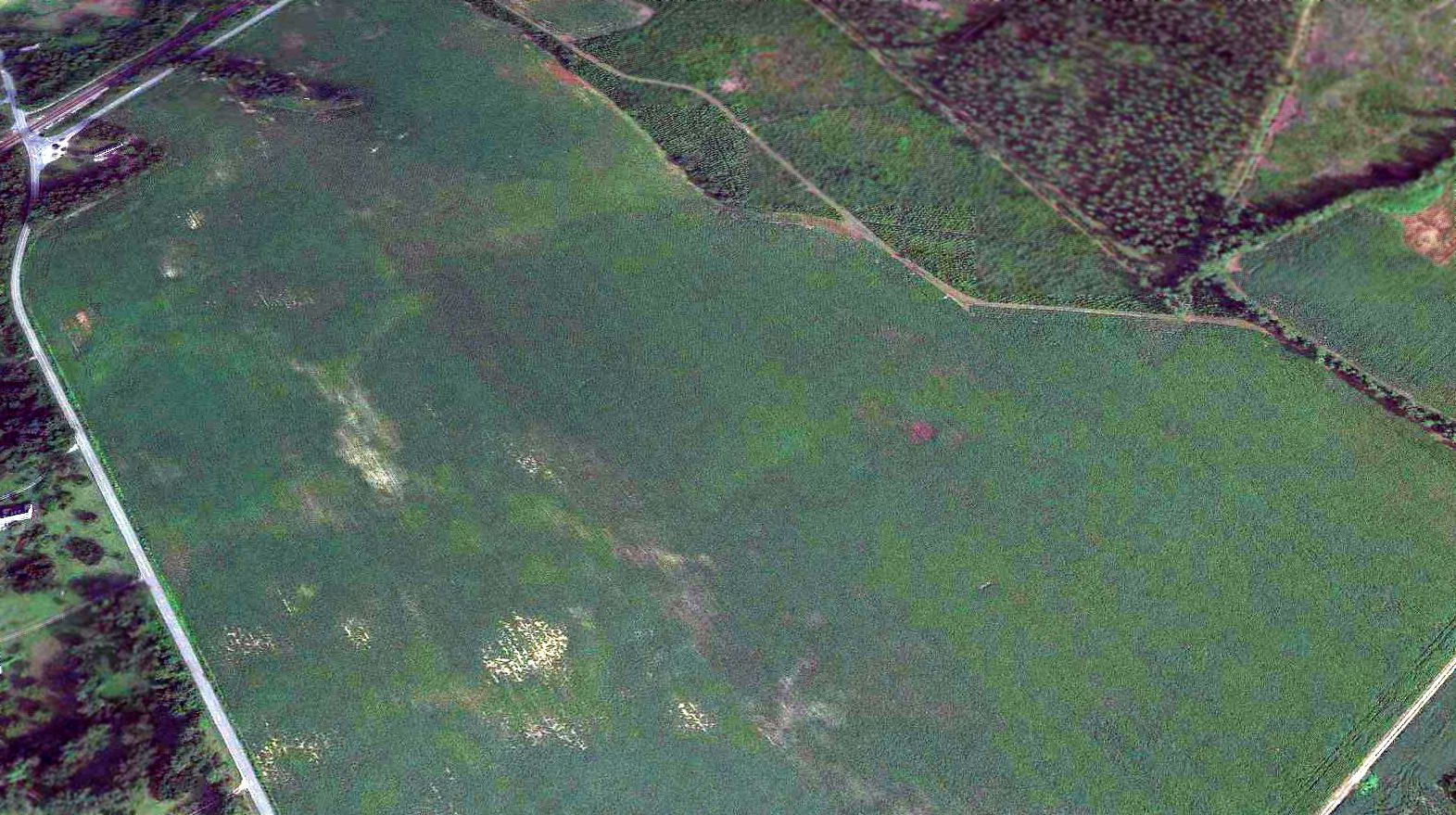
A 2017 aerial view looking northwest shows no trace remaining of Lane Airport, with the airfield having been returned to cultivation.
The site of Lane Airport is located east of the intersection of Route 377 & Route 375, adjacent to the tiny community of Gourdin.
Thanks to Bill Carter for pointing out this airfield.
____________________________________________________
34.49, -80.6 (Northeast of Columbia, SC)

Kershaw Municipal Airport, as depicted in the 1945 AAF Airfield Directory (courtesy of Scott Murdock).
The Kershaw Airport was evidently established at some point between 1944-45,
(as were so many other new airports across the county, after the end of WW2),
as it was not depicted at all on the November 1944 Charlotte Sectional Chart (according to Chris Kennedy).
The earliest reference to the field which has been located
was in the 1945 AAF Airfield Directory (courtesy of Scott Murdock).
The directory described Kershaw Municipal Airport as a 63 acre irregularly-shaped field having 2 turf runways:
2,100' WNW/ESE & 1,800' ENE/WSW.
It not said to have any hangars, to be owned by the City of Kershaw, and to be operated by private interests.
The Haire Publishing Company's 1945 Airport Directory (courtesy of Chris Kennedy) described "Kershaw Airport" as a "class 1" facility, owned by the City.
The operator & manager was listed as O. A. Williford.
It was said to have 2 sod runways: a 2,100' northwest/southeast strip, and an 1,800' northeast/southwest strip.
The field was said to offer a hangar, repairs, and fuel.
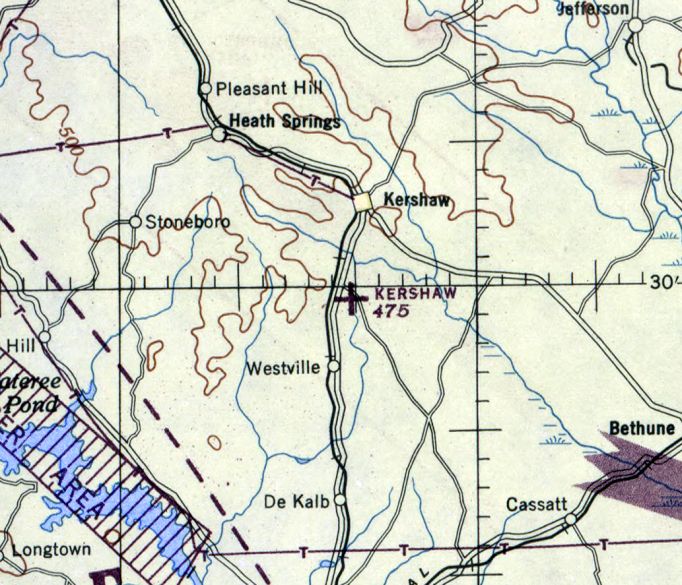
The earliest aeronautical chart depiction of the Kershaw Airport which has been located was on the April 1945 Charlotte Sectional Chart.
It depicted Kershaw as an auxiliary airfield.
The October 1948 Charlotte Sectional Chart (courtesy of Chris Kennedy) still depicted Kershaw as an auxiliary airfield.
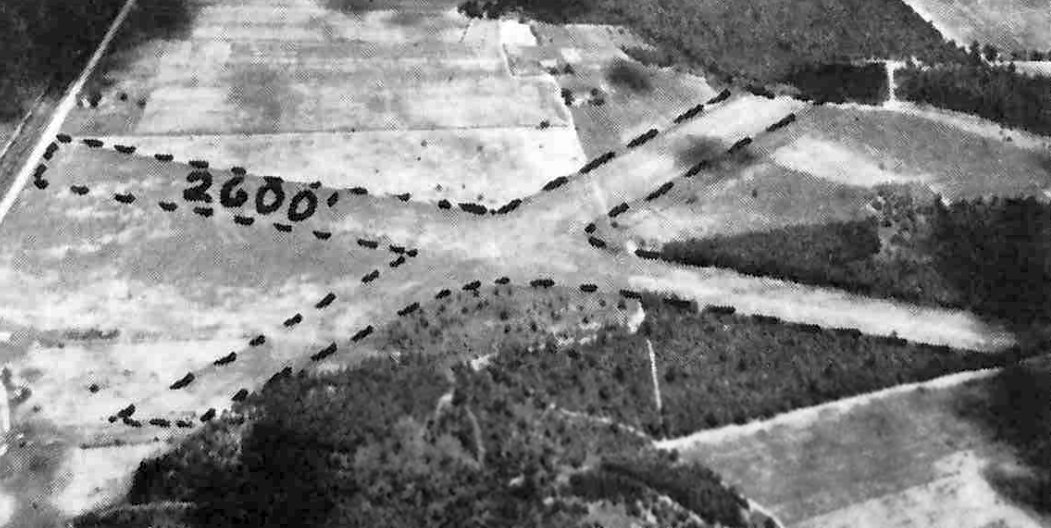
The earliest photo which has been located of Kershaw Airport was an undated aerial view looking north from a circa 1957 SC Airport Directory (courtesy of Don Fraser).
It depicted Kershaw as having 2 unpaved runways in an X-shape, btu there were no buildings visible on the field.
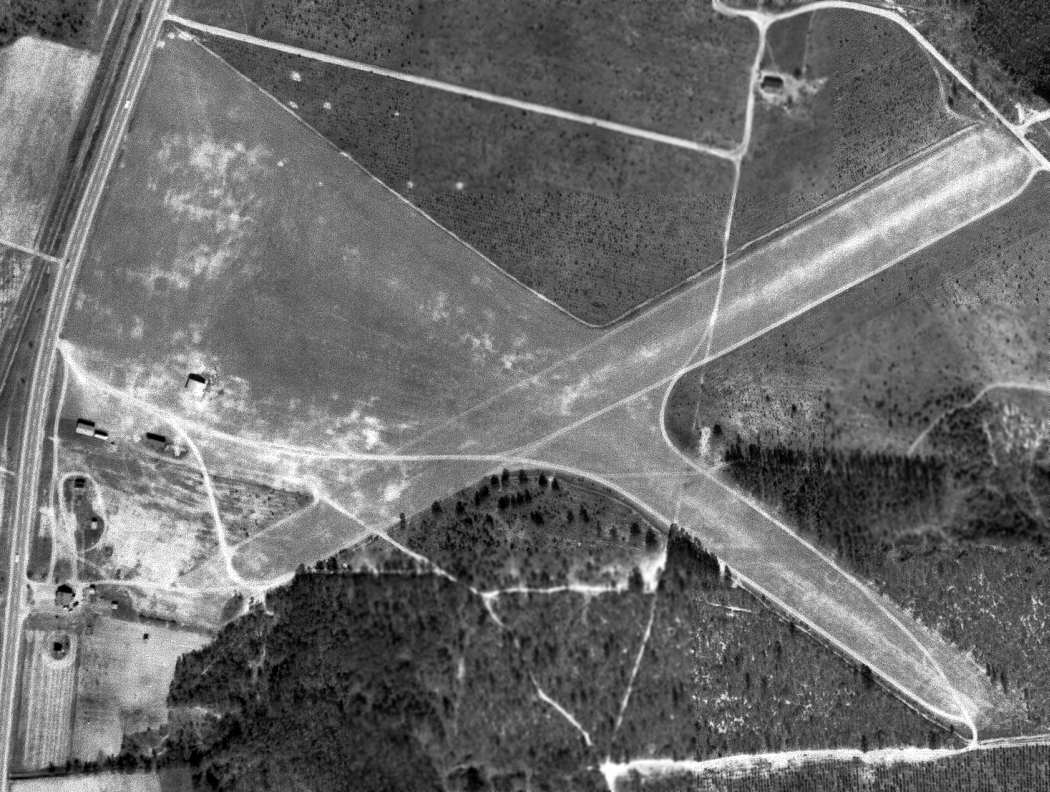
The last photo which has been located showing Kershaw Airport still operational was a 2/14/64 USGS aerial view.
It depicted Kershaw as having 2 unpaved runways in an X-shape.
The April 1966 Charlotte Sectional Chart (courtesy of Chris Kennedy) depicted Kershaw Airport as having a 2,500' unpaved runway.
Kershaw Municipal Airport was still listed (although in the "Low-Use Airport" section)
of the 1987 Flight Guide (according to Chris Kennedy).
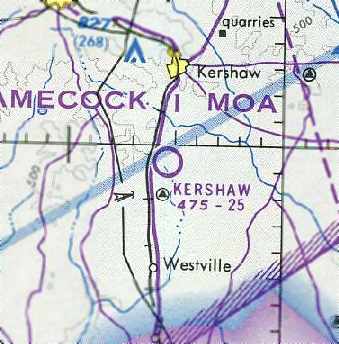
The last aeronautical chart depiction which has been located of the Kershaw Airport
was on the August 1988 Charlotte Sectional Chart (courtesy of Chris Kennedy)
It depicted Kershaw Airport as a public-use airport having a 2,500' unpaved runway.
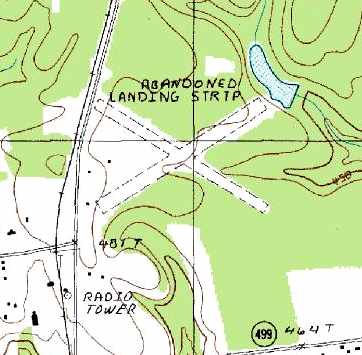
Kershaw Airport was evidently abandoned in 1988, as it was labeled "Abandoned Landing Strip" on the 1988 USGS topo map.
The 2 runways were still depicted, though.

In the 1994 USGS aerial photo the former Kershaw Airport's 2 grass runways were still cleared & in quite good condition.
A few buildings were located on the west side of the airfield, but it is not known if those dated to the site's days as an airfield.
The property of the former Kershaw Airport was acquired in 1998 by a group led by Joe Hooker & Bob Humphreys,
and construction started soon thereafter on the Carolina Motorsports Park, a 2.3 mile club-level road racing course.
The track opened in July 1999.
Note that the race track's web site claims that "The site is an old World War II fighter-training base",
but no evidence has been found to confirm the assertion that the airfield was in use earlier than 1945,
or that it was ever a military field.

A 2014 aerial view at the Carolina Motorsports Park, which has obliterated any trace of Kershaw Airport.
The site of Kershaw Airport is located southeast of the intersection of Route 521 & Old Georgetown Road.
Thanks to Chris Kennedy for pointing out this airfield.
____________________________________________________
Since this site was first put on the web in 1999, its popularity has grown tremendously.
If the total quantity of material on this site is to continue to grow,
it will require ever-increasing funding to pay its expenses.
Therefore, I request financial contributions from site visitors,
to help defray the increasing costs of the site
and ensure that it continues to be available & to grow.
What would you pay for a good aviation magazine, or a good aviation book?
Please consider a donation of an equivalent amount, at the least.
This site is not supported by commercial advertising –
it is purely supported by donations.
If you enjoy the site, and would like to make a financial contribution,
you
may use a credit card via
![]() :
:
Please consider checking the box to make a monthly donatation.
For a mailing address to send a check, please contact me at: paulandterryfreeman@gmail.com
If you enjoy this web site, please support it with a financial contribution.
please contact me at: paulandterryfreeman@gmail.com
If you enjoy this web site, please support it with a financial contribution.
____________________________________________________
This site covers airfields in all 50 states.